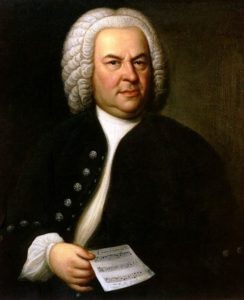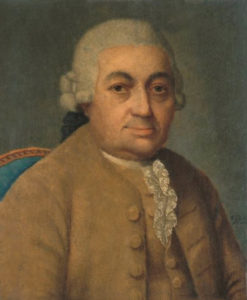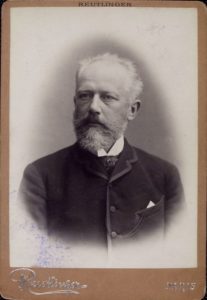
Flute sonata in E-flat Major, BWV 1031
J.S. Bach (1685 – 1750)
Coming from a long line of German musicians, Johann Sebastian Bach began his professional career at eighteen as a church organist. His first important position (1708-17), as 
Many Baroque composers favored the trio sonata for two solo instruments and basso continuo (harpsichord plus bass instrument). Bach’s ensemble sonatas, however, are works for one solo instrument plus harpsichord. Using a simple and ingenious procedure, Bach adapted the trio sonata texture by giving the second melody line to the right hand of the harpsichord player while the bass part was assigned to the left hand. In some movements of these sonatas, however, Bach wrote true trios for three almost equal voices—violin, keyboard treble, and keyboard bass—rather than continuing in the vein of the traditional trio sonata.
One such sonata is the Flute sonata in E-flat Major, dating from the 1730s. It might have been a joint venture between J.S. Bach and one or the other of his two eldest sons, perhaps Carl Philipp Emanuel; Bach scholar Robert Marshall, however, believes that it was probably composed by J.S. Bach. British music historian Nicholas Anderson observed: “What is indisputable … is the high quality of its craftsmanship and its expressive charm.”
A sonata in three movements, the first movement Allegro moderato opens with a harpsichord introduction, followed by the flute, which presents the main theme. The two instruments toss short phrases back and forth to create a light, galant-style opening movement. The oft-played Siciliano features a lyrical, haunting melody in the flute with an arpeggiated accompaniment in the harpsichord. The final Allegro, in a two-part form with repeats is a lively conclusion to the sonata. The two upper parts are equal partners in this fast-paced final movement.
Siete Canciones Populares Españolas
Manuel de Falla (1876 – 1946)
Spanish composers Isaac Albéniz, Enrique Granados, and Manuel de Falla were the first Spanish composers in over 300 years to win international acclaim. De Falla’s musical 
Around the time of his return to Spain in 1914, de Falla composed Siete canciones populares españolas (Seven Popular Spanish Songs), originally a set of Spanish folksongs in traditional form for mezzo-soprano or baritone and piano. The songs in this suite include El paño moruno (The Moorish Cloth), Seguidilla murciana, Asturiana, Jota, Nana, Canción, and Polo. El paño moruno, from the province of Murcia near Andalusia, is an earthy, erotic piece characterized by accented second beats; arpeggiated chords create a guitar-like accompaniment. The Seguidilla is an Andalusian dance in quick triple time. A peaceful lamentation, the Asturiana of northern Spain evokes the grief of a mourner with its underlying pedal point accompaniment. The Jota, from the province of Aragon, is a rapid dance in triple time usually accompanied by castanets; more plaintive sections in de Falla’s setting provide contrast. Nana is an Andalusian lullaby with a gently syncopated accompaniment representing the rocking of a cradle. The next song, Canción, is a popular folk melody, which gives voice to the lament of a forlorn lover. The suite concludes with the dazzling Polo in a flamenco style with rapid accents evoking the handclapping of the spectators.
These songs, which are simultaneously music and dance, have a strange, evocative power. Listening to them, we find ourselves dreaming about the stamping feet, the long voluptuous spasmodic movements, and the heel clicking of the woman dancer who twists her arms as she strikes the castanets. We hear the raucous notes, cleverly broken and lowered, the vocal tremolos, the harsh sobs of the singer.” (Demarquez)
Three Jewish Dances, Op. 192
Marc Lavry (1903 – 1967)
A Latvian composer born as Marc Levin, he began composing piano pieces at age nine. In Berlin he studied conducting with Bruno Walter and composition with Alexander Glazunov. It was in Germany that he changed his name to Lavry to avoid confusion with another older composer. When the Nazis took power in Germany, he returned to his native Riga; as anti-Semitism intensified in Latvia, he and his wife immigrated to Palestine.
I immigrated to Israel in 1935 and immediately felt that I found my spiritual homeland … nowhere until arriving to Israel, did I feel that grounded. I felt that I landed where I belong and that I found a place worth fighting for. I felt that the country inspired me as a composer and that here I wrote my best compositions.
In Israel Lavry developed the “Mediterranean School” of composition that merged elements of Arabic and Jewish music with western art music. His compositions – more than 400 – range from grand operas and symphonies to chamber music and popular songs; he was also a prolific arranger and orchestrator. Throughout his life he promoted the music of Jewish composers.
A decade after immigrating to Israel Lavry composed a compilation of Jewish dances which became Op. 192. The first, Sher (Scissors Dance), is a Hassidic-Jewish dance inspired by music he heard as a child. The Wedding Dance of the shy Yemenite bride is gentle; the dance was performed in small steps with soft movements of the hands. Lavry adapted the energetic rhythms of the Hora for the final dance in the set. In a radio interview Lavry said: “… I remember that after I visited Kibbutz Degania where we danced all night, the dance left a huge impression on me. An endless Hora dance — with shouts and rhythmic legwork — the young people were wonderful.”
Violin Sonata in G minor, H. 542.5
C.P.E. Bach (1714 – 1788)
The great composers of the Classical period, Mozart, Haydn, and Beethoven, greatly admired Carl Philipp Emanuel Bach, the second of J.S. Bach’s five sons. Mozart wrote of 
Until the middle of the twentieth century, Sonata for Violin and Keyboard was believed to be a sonata for flute or violin and keyboard by Johann Sebastian Bach catalogued as BWV 1020. Many musicologists have weighed in with their reasons for ascribing the sonata to either the father or the son. In a 2003 study Keiichi Kubota speculated that it is possibly a collaborative teaching effort between father and son, but there is still no definitive answer for the authorship of the sonata. For this recital we give Carl Philipp Emanuel Bach credit. Composed in 1734 and first published in 1860, the Sonata is in three movements in the typical fast-slow-fast design. It opens with an energetic Allegro with a lyrical spinning-out melody in the solo instrument. A gentle Adagio in a major key follows and features a sweet and tender melody for the solo instrument. The final Allegro has long sweeping lines in both instruments.
Sections from The Seasons, Op. 37a
Pyotr Ilyich Tchaikovsky (1840 – 1893)
From an early age Pyotr Ilyich Tchaikovsky showed an intense delight in music, but any serious musical education was delayed until 1861 when he resigned his clerking job at the
Tchaikovsky composed The Seasons, a suite of twelve short character pieces (short musical compositions with a single mood or impression) for piano, between 1875 and 1876. The publisher Nikolay Bernard commissioned the pieces for monthly installments in his St. Petersburg musical-theatrical journal Nouvellist:
Our celebrated composer P. I. Tchaikovsky has promised the editor of Nouvellist, that he will contribute to next year’s issues a whole series of his piano compositions, specially written for our journal, the character of which will correspond entirely to the titles of the pieces, and the month in which they will be published in the journal…
Most of the pieces are in simple three-part form. For each piece the publisher suggested an accompanying verse. A number of musicians have arranged selections from The Seasons for different instruments.
Avital and Kibbey will perform four of the pieces from The Seasons. In June, subtitled Barcarolle, the verse by Aleksey Pleshcheyev is:
Let us go to the shore;
there the waves will kiss our feet.
With mysterious sadness
the stars will shine down on us.
This Andante cantabile in G minor is a quiet song; the middle section especially reminds us of the lapping Venetian waters against a gondola.
The quiet D minor Autumn Song for October is a musical expression of a dying garden. The Andante doloroso e molto cantabile includes a verse by Aleksey Konstantinovich Tolstoy:
Autumn, our poor garden is all falling down,
the yellowed leaves are flying in the wind.
In the gentle waltz of Noël for December Tchaikovsky paints a happy Christmas Eve scene with words by Vasily Zhukovsky:
Once upon a Christmas night
the girls were telling fortunes:
taking their slippers off their feet
and throwing them out of the gate.
The Andantino expressivo Song of the Lark in which birdsong can be heard, reminds us of the reawakening earth and spring, expressed by Apollon Maykov:
The field shimmering with flowers,
the stars swirling in the heavens,
the song of the lark
fills the blue abyss.
Cuatro madrigals amatorios
Joaquín Rodgrigo (1901 – 1999)
Spanish composer, pianist, and musicologist Joaquín Rodrigo was left with impaired vision and then lost his sight after a diphtheria outbreak in 1905. His musical gifts became apparent at a young age; he began studying the piano and violin at age eight and harmony and composition at age sixteen. In 1927 his musical studies took him to Paris where he studied with Paul Dukas at the École Normale de Musique. The Spanish Civil War made life in Spain difficult, but with help from colleagues, including de Falla, he received various appointments. From 1947 he was a professor of music history at the Complutense University of Madrid. His reputation as a great Spanish composer gained increasing international acclaim: in 1983 he received the Premio Nacional Música; in 1991 King Juan Carlos I bestowed on Rodrigo the hereditary title of Marqués de los Jardines de Aranjuez. He composedmore than two hundred compositions, including orchestral pieces, concertos, songs, and instrumental music for guitar, piano, violin, cello, and other instruments. He wrote his compositions in Braille and then they were transcribed for publication.
Rodrigo composed Cuatro madrigales amatorios (Four Madrigals of Love) in 1947, setting anonymous poetry from the sixteenth-century anthology of Juan Vásquez. In the late 1930s, he heard these poems set to Renaissance music accompanied by vihuela (a fifteenth-century fretted plucked Spanish string instrument shaped like a guitar but tuned like a lute). Set for soprano and piano, Rodrigo created a song cycle which examines different facets of love, including despair and delight. The first two songs, ¿Con qué la lavaré? (With what shall I bathe?) and Vos me matásteis (You have slain me), reflect the sorrow and grief of the texts, perhaps loss through death or divorce. In the third song, ¿De dónde venís, amore? (Where have you been, my love?), Rodrigo answers the mood of the first two songs with a more lighthearted piece and suggests that things not be taken too seriously. For the final song, De los álamos vengo, madre (I come from the poplars, Mother), he used a traditional melody with his own guitar-like accompaniment. A year later Rodrigo orchestrated Cuatro madrigales amatorios for two flutes, oboe, bassoon, horn, and strings.
Linda Russell, a member of Maine Music Teachers Association and an independent piano teacher, lives in Portland with her longtime spouse
Avi Avital & Bridget Kibbey
7:30 PM
Tuesday, February 18, 2020
Hannaford Hall, USM Campus, Portland
Click here for tickets
